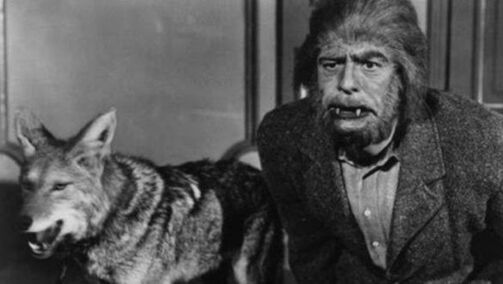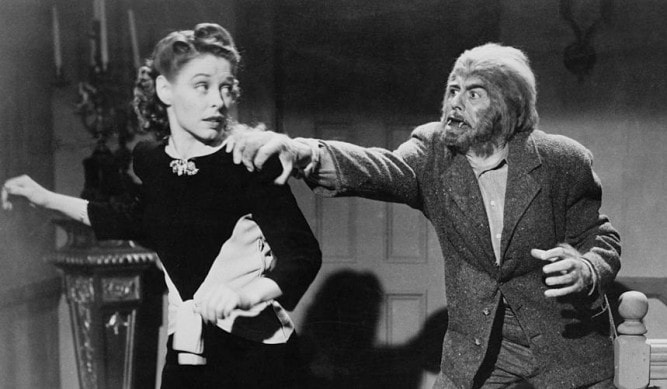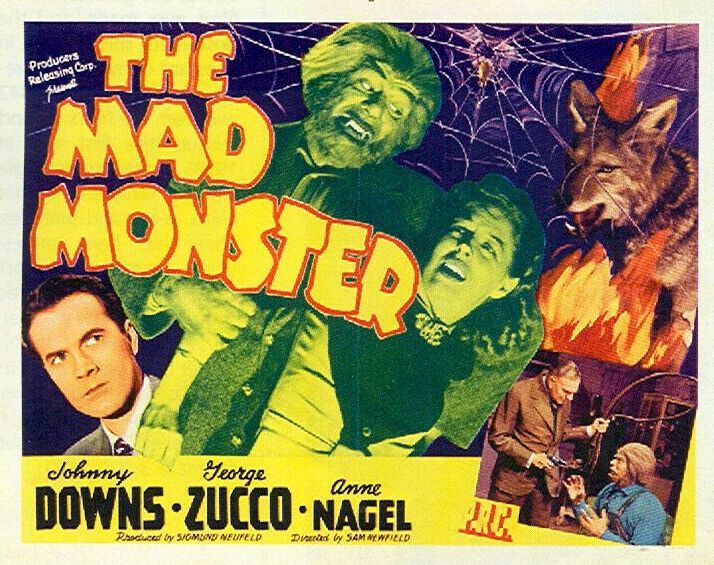[Tearing Through Werewolf Cinema] 'The Mad Monster' was a Hackneyed but Lively Lycanthrope Film7/1/2020  Welcome to a weekly series in which Doris V. Sutherland takes readers on a trip through the history of werewolf cinema... ...In The Mad Monster (1942), Dr. Lorenzo Cameron (George Zucco) gives his assistant Petro (Glenn Strange) a transfusion of wolf’s blood, causing the simple-minded handyman to turn into a snarling, hirsute killing machine. The doctor is pleased with the results, furthering as they do his ultimate goal of building an army of invincible werewolf soldiers. But before then, he plans to send his creation to pick off each and every one of the scientists who scoffed at him. The first non-Universal werewolf film of the sound era, The Mad Monster is very derivative, but at least chooses an unusual set of sources to borrow from. Even though Universal had codified the Hollywood version of werewolf lore the previous year with The Wolf Man, The Mad Monster completely ignores this and instead roots its werewolf in mad science, bringing back the lycanthropy-by-blood-transfusion gimmick seen in 1925’s Wolfblood. On top of this, instead of riffing on Dr. Jekyll and Mr. Hyde – the most obvious inspiration for a mad scientist-werewolf story – the film’s plot turns out to be a strange hybrid of Frankenstein and Of Mice and Men. There’s no internal angst on the part of the werewolf Petro, as his human form is a good-natured dimwit – clearly modelled on Lon Chaney Jr’s portrayal of Lennie in the 1939 film of the Steinbeck story – too gormless to be aware of his alter ego’s rampages. The central villain is not the werewolf at all, then, but rather the scenery-chewing mad scientist Dr. Cameron, who has gleefully unleashed the monster on the world. With the wolf-man loose, it falls upon eager young reporter and protagonist Tom Gregory (Johnny Downs) to investigate the reports of a strange two-legged monster. Superstitious locals say that a werewolf is abroad (“you can’t kill them noways, ‘cept with a silver bullet” cackles one eccentric elderly lady) but Tom starts out with a very different theory: that the area is home to a dinosaur. He speaks to Dr. Cameron about “the possibility of the survival in the depths of the swamp of some of those overgrown lizards that used to be headmen on Earth – I understand that they travelled around on their hind legs and made our present-day public enemies look like horticultural specimens.” Yes, this is a b-movie through and through. But it’s a b-movie that conducts itself with commendable gusto. Take the very first sequence: after the werewolf undergoes his transformation (yes, in the first scene) Dr. Cameron imagines the reactions of his scientific rivals, who appear as hallucinations to fill in the film’s backstory that Cameron is seeking revenge on his peers. While this is the most hackneyed mad scientist motivation imaginable, the film manages to find an inventive way of putting it onscreen. If a film can’t be original or convincing, it can at least be lively, and The Mad Monster succeeds in that aim. Despite being generally cruder than Universal’s efforts, Mad Monster manages some atmospheric sequences, including shots of the werewolf lumbering through a mist-shrouded bayou, a transformation scene set in a car, and an expressionistic silhouette strangulation near the end. George Zucco is as watchable as ever in his portrayal of the unhinged, gloating Dr. Cameron, while Our Gang graduate Johnny Downs puts in a likeably boyish turn as the reporter hero. Glenn Strange – later picked by Universal as the fourth of its Frankenstein Monsters – is something of a weak link, his slowpoke routine soon outstaying its welcome. Rounding out the cast is Anne Nagel, who makes a pleasant but unmemorable heroine as Dr. Cameron’s innocent daughter. A diverting bit of cheeseball silliness, The Mad Monster is mainly notable for demonstrating just how prevalent the theme of the mad scientist was in horror films of this period. Even after Universal had put together a werewolf formula all ready to be adapted and imitated, its rivals were still heading back to the lab and slab for inspiration. By Doris V. Sutherland Enjoy Doris' writing? Leave her a tip here through Ko-fi!
0 Comments
Leave a Reply. |
Archives
March 2023
|


 RSS Feed
RSS Feed